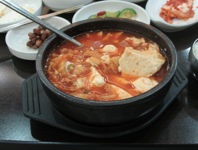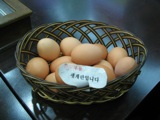I came across this article in the Korea Times the other day. Apparently Japanese who protest the singing of Japan’s national anthem, 君が代 (J) have created an English parody of the song. The pronunciation is said to be similar enough not to be noticed when students sing it. The Guardian also picked up the story. Both refer back to the right-wing Sankei report on this which can be read here. The lyrics of the song are also reported to make a reference to comfort women.
I read the article while in a subway station in Seoul. I asked Sayaka what the lyrics for 君が代 were again and she proceeded to sing the song. She did this three times, struggling each time to remember the words, before it suddenly occurred to me that it probably isn’t such a good idea for a Japanese person, in a Korean subway station, to be singing the Japanese national anthem out loud. I stopped her and reminded her that her father had explicitly emailed her before she left for Korea and issued her a very formal and detailed warning on how not to provoke the Koreans by, for example, bringing up sensitive historical and territorial issues. He had neglected to tell her not to sing the Japanese anthem in crowded public places.
As you might expect if you have read any of my previous postings, I’m sympathetic to those who want to resist the reintroduction of flag and anthem rituals in the Japanese schools and find it unfortunate that the government affirmed both officially in a 1999 law. On the other hand, from a tactical standpoint, I really don’t think this fight is worth the effort. I don’t think it is possible in the current global and Japanese climate, to make any progress in a movement to oppose the national anthem and flag—even when it evokes images of a troubled national past.
I understand, however, that for younger students, this is one of the only issues where they may personally get involved. They can feel the exhilaration of refusing to sing an anthem which celebrates the Japanese imperial reign and thus get their first taste of civil disobedience. Though far less controversial than their early predecessors, they can join in a long tradition dating back to that historic moment when the Christian Uchimura Kanzô refused to bow at the reading of the Imperial Rescript on Education.
Instead of disrupting school ceremonies, refusing to show, or remaining silent, I think a humorous parody of the anthem is a wonderful idea. If translating the US anthem into Spanish is enough to get US nationalists all wound up, then a witty parody of the Japanese anthem if students are able to get away with singing it. I can almost see their devious chuckles as they sing it. Unlike the provocative Danish cartoons, which I think were simply a bad idea on pragmatic grounds and not problematic in principle, this is highly unlikely to cause violent riots in, say, Kagoshima.
Then I read the lyrics:
Kiss me, girl, your old one.
Till you’re near, it is years till you’re near.
Sounds of the dead will she know?
She wants all told, now retained, for, cold caves know the moon’s
seeing the mad and dead.
What the…?! Oh no…is it possible that my favorite T-shirt company was commissioned to write the lyrics of the parody?
The Sankei article tries to help us understand how on earth this resembles the anthem enough to go unnoticed:
歌詞は、本来の歌詞と発声が酷似した英語の体裁。例えば冒頭部分は「キス・ミー・ガール・ユア・オールド・ワン」で、「キー(ス)・ミー・ガー(ル)・ヨー・ワー(ン)」と聞こえ、口の動きも本来の歌詞と見分けにくい。
I’m sorry, this is just pathetic. The song does bear some resemblance to the sounds of the original lyrics when you pronounce the English words in their Japanese katakana equivalents, but it is neither humorous nor does it make any sense. This is nowhere near the talented work that lies behind something like Hatten är din (Flash).
I suggest we help these students by giving them something better to work with. Any volunteers to help?
Here are the original Japanese lyrics:
君が代は
千代に八千代に
さざれ石の
いわおとなりて
こけのむすまで
The pronunciation:
きみがよは
ちよにやちよに
さざれいしの
いわおとなりて
こけのむすまで
Romanized:
Kimi ga yo wa
Chiyo ni Yachiyo ni
Sazare ishi no
Iwao to narite
Koke no musu made
Remember, if we make alternate lyrics, our satirical bite will be limited somewhat since we have to make the new version sound as phonetically close as possible to the original. Also, since it will be sung by young Japanese students, we should avoid English sounds that are difficult for Japanese to create. Post your recommendations in the comments! Finally, like the original Japanese attempt we should keep in mind that the Japanese pronunciations of English words aren’t always what you might expect.
 In my humble opinion, one of the most delicious dishes on the planet is kimchi sundubu. Sundubu, a spicy tofu soup-like dish comes in many varieties but since I’m not a big fan of seafood, I prefer it when it is served without clams or other seafood in it. I have found that restaurants offering more than one variety and serving “kimchi sundubu,” will, in addition to adding kimchi to the soup, often give you a few scraps of beef in the dish instead of clams.
In my humble opinion, one of the most delicious dishes on the planet is kimchi sundubu. Sundubu, a spicy tofu soup-like dish comes in many varieties but since I’m not a big fan of seafood, I prefer it when it is served without clams or other seafood in it. I have found that restaurants offering more than one variety and serving “kimchi sundubu,” will, in addition to adding kimchi to the soup, often give you a few scraps of beef in the dish instead of clams.